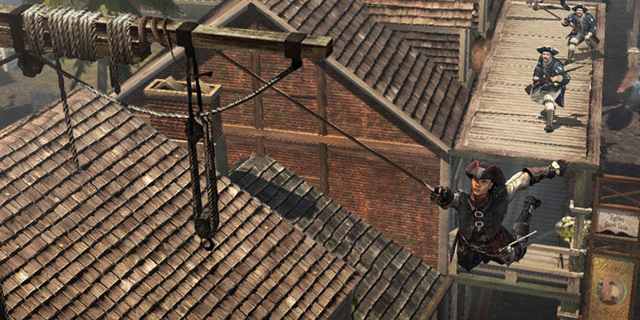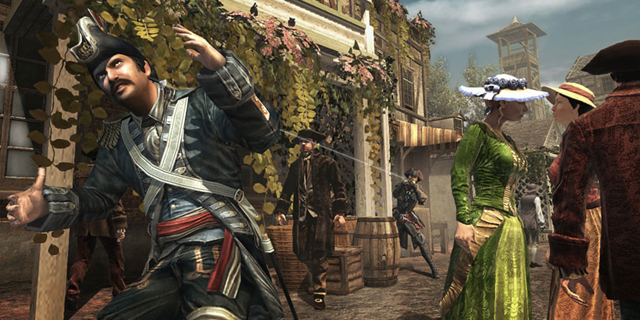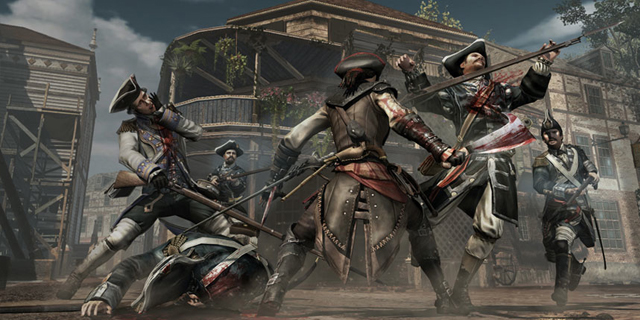
Portable entries of big franchises are usually created one of two ways: They are an attempt to emulate the gameplay of the main games as best as possible, or they are something different entirely. The latter usually focuses on experimentation while trying to stay as connected as possible to the original games. The former, on the other hand, rarely succeeds, mostly due to the hardware limitations of the handheld in question. Ubisoft has tried both approaches with Assassin’s Creed, but thanks to the Vita’s impressive technical specs, the former finally seems entirely plausible for the franchise. Assassin’s Creed III: Liberation is that game, blending together well-known elements of the series with some Vita-specific gimmicks that rarely succeed.
The first thing you’ll notice is how gorgeous Liberation looks. Like Uncharted: Golden Abyss before it, this is a game that really showcases the Vita’s hardware strengths while also demonstrating it is the true “console gaming on the go” experience. Not only are the visuals quite stunning, but the frame rate also remains mostly consistent throughout. Unfortunately, there are some moments where the game chugs when surrounded by large crowds of people, and some other technical issues, such as clipping problems that sometimes interfere with combat and exploration, do bog the experience down a bit. These moments only stand out mostly due to the how polished the presentation is overall.

It may look nice, but if you’re putting an Assassin’s Creed game on a handheld in an attempt to bring that experience on the go, you need to recreate the feeling of the movement in the series as faithfully as possible. Thankfully, Liberation’s controls feel tight and the movement is wonderful. Running around New Orleans is as satisfying as exploration in any console iteration and you always feel like you’re in complete control of the character. It nails the movement down as precisely as it needs to and that goes a long way to make the game a lot of fun to play.
Missions are structured in a typical Assassin’s Creed fashion. You have escort missions (everyone’s favorite), eavesdropping missions, tailing missions and, of course, your assassination missions. There are some attempts to freshen things up a bit, and sometimes they really do succeed. One mission involves you having to ambush a large group of Spanish soldiers, and to do so you need to block all of their available paths. This focuses on running from rooftop to rooftop, knocking over water towers in specific positions in order to ensure they can’t escape. There are a few more like that and they do a lot to keep things from getting old, but a lot of the missions never have much of an impact on the overall experience and, after a while, feel like more of the same.

The missions that absolutely do not work are those that rely on the Vita’s touch controls in one way or another. A lot of these are simple, such as swiping the front screen and rear touch pad at the same time to open a letter, but others, including using the rear touch pad to control the rowing speed of a canoe, are awful. And then there are the puzzles, most of which are gimmicky, barely functional, and bring the entire game to a grinding halt. One puzzle in particular has you using the Vita’s tilt controls to move a marble from one end of a maze to another. Not only did it interpret a lot of the motions wrong (when I tilted left, the puzzle moved right), but sometimes it would just get stuck in a certain position no matter how often I tilted the system and it forced me to restart. There aren’t a lot of these scattered throughout the game, but all of them are tedious and unnecessary.
And then there’s the combat, which ranges from satisfying to messy. It attempts to recreate the combat from the main games as best as possible, but only partially succeeds. The good news? There are plenty of fun new weapons to try out, including a blow pipe, which is a long range weapon that offers a nice, quiet alternative to firing your pistol, and a whip, which allows you to pull enemies towards you to get a quick kill. Unlike in previous games, however, a lot of the combat is never quite satisfying. There is a disconnect between your button presses and the actions on the screen. Sometimes, when needing to counter an enemy at a precise moment, you will find yourself missing for no good reason despite timing it right. It’s not terrible, but it’s only barely serviceable and seems like a huge misstep compared to how well they handled the movement.
If there was anything I was hoping not to be disappointed by, it’s the story. Sadly, it’s completely unfocused and there are many times when you simply won’t understand what you’re doing, who you are going after, or why any of what is happening actually matters. The narrative thread follows Aveline, a young assassin attempting to free slaves from Spanish control and ultimately stop those who wish to keep them under their control. At least, that’s what I assume is happening, because it is absolutely never made clear. Certain missions have goals, but those goals are rarely connected to the bigger picture. And Aveline, who has the potential to be an intriguing character, never gets the development she deserves. It’s all completely messy and the big story moments that should have impact never do.
Ubisoft Sofia deserves credit for creating the first real Assassin’s Creed game on a portable device, but it really could have pushed a little further. Assassin’s Creed III: Liberation clearly has a lot of great ideas to work with, but most of them feel undeveloped and the game is sometimes bogged down by an unnecessarily muddled story and a strange focus on the Vita’s functionalities. When played in chunks, it’s a lot of fun, and it absolutely nails the feel of the console games. As a whole, however, it never quite lives up to those games, and most of it feels like an afterthought.
Pros: Strong presentation, fun new weapons, controls are solid and movement feels like Assassin’s Creed
Cons: Terrible (and gimmicky) puzzles, unfocused story, mushy combat, numerous technical problems



















